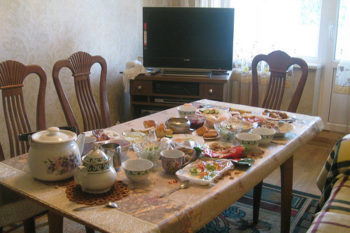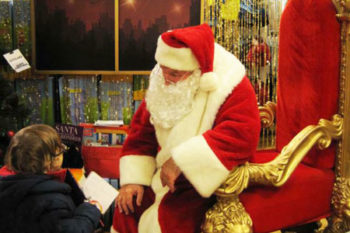
Closer to Taipei than Tokyo, Okinawa is a chain of islands stretching from Taiwan to Kyushu. Once an independent nation, known as the Ryukyu Kingdom, it prospered as a natural sea lane between China, Japan and all of Southeast Asia and the influences of these cultures are evident today.

A day of driving the main island (there are 160 islands in total) could give a visitor the feeling they have traveled through a time machine. From the high-rise hotels and office buildings in the capitol city of Naha, past the McDonalds and Dunkin’ Donut Shops you’d loose count of the wooden-framed, red-tiled roof homes you passed.
Within an hour you could visit any one of five UNESCO World Heritage Castle Sites, drive to the mountainous north, visit Five Star Resorts, or find a secluded beach. You are just as likely to see someone clad in a kimono as you are to see someone wearing a bikini. There may be people wearing traditional garments, beating drums and playing the three-stringed sanshin (a ukulele-like instrument) and singing in a language even the Japanese don’t comprehend. You are just as likely to run across youth singing rap or break dancing.
Early to mid-morning, you may hear trucks driving around slowly and playing loud music; it’s the trash collection day. You could run across smaller trucks with loudspeakers blaring, “Yaki imo, yaki imo, oishii, oishii, yaki imo”. Baked Okinawan sweet potato, purple in color, wrapped in foil and cooked in a wood-burning smoker, right on the back of a pickup truck, that’s what the driver is shouting about.
Evenings, softer music may be coming from a box-shaped mini truck parked halfway down a street or in an apartment complex parking lot. That’d be a bread and pastry truck and it seems they attract a crowd of young mothers and children. Men, farmers, fishermen, construction workers tend to socialize over a drink or two with their coworkers before heading home.
In the fields you are more likely to see sugar cane and rice being planted, cultivated and harvested by hand, rather than with machinery. Along the coasts fishermen and egrets may be spotted side by side, seeking the same catch. During low tide, people may be seen hand-picking mussels and shells from the mud flats. At high tide or in deeper waters, scuba divers, wake boarders, jet and water-skiers, kayakers and snorkelers take advantage of the crystal-clear waters.
Year round, just about every Sunday on Okinawa a sport more popular than Japanese Sumo Wrestling takes place. Bullfighting, not the type with Matadors, knives and blood; two bulls in a ring compete against each other. It’s similar, in many respects, to human Sumo, only these wrestlers weigh around a ton apiece. They are pampered like family pets and everyone gets to go home alive.
May to November is Festival Season on this island. There are flower festivals, health festivals, dragon boats, sunshine, planting, harvest, sea, and fertility festivals. I’ve been to beer festivals, children’s festivals, bug and animal festivals, ancestor worship festivals, religious and maybe even sacrilegious festivals. There are just too many festivals to remember so, over the course of the next year, I’ll try and post some photos and explanations as to how all these events relate to the culture of my home, Okinawa, Japan.
This is Mike’s first post for PocketCultures. Originally from the USA, Mike has lived in Okinawa for 30 years and will be writing about Japan. Find him on Ryukumike’s Blog, or admire his photos on Mike’s Ryuku Gallery.
Read more:
21st Century sounds from Japanese fusion bands
Japanese breakfast (Food of the World)
Mabuhay! Meet Bryan and discover the Philippines











I have to admit I didn’t really know anything about Okinawa, so this was a great introduction – thanks Mike. The photos are stunning too.
When you say you can hear languages other than Japanese, is that from visitors or are there other languages spoken by Okinawans? (if that’s what residents are called – please correct me if I got it wrong!)
Sorry, I should have clarified that. Okinawans have a language, “Uchinaguchi” )in their dialect)it’s called Okinawa Hogen, by mainland Japanese.
While all Okinawans speak Japanese, I don’t think anyone from mainland understands Okinawan Hogen except, possibly a linguist.
Great post on Okinawa ! Using a mere 551 words, Mike, you have summarised the typical ‘A Day in the Life of Okinawa’ evocatively 🙂 ! Your pictures have added more meaning and ‘eyes’ to the place.
After reading your post, I feel like I’ve lived there long enough that I do not have to ever visit the place personally !! LOL !
Keep posting more and more …
Best Regards,
Sumitran
P.S. While the picture of nubile girls in bikinis prancing in the sands is intriguing, you have not said who they are and why they are jumping about !!!
Sumitran,
Thanks for taking the time to visit. The gals jumping on the beach were striking a pose for an award-winning photo. Unfortunately it wasn’t taken with my camera.
Five-thousand words couldn’t describe a day on Okinawa. You must come visit.
Well, you’ve inspired me to visit!
Can’t believe I haven’t been to Okinawa yet. Looks so lovely. Really like the dragon boat photo, so bright and colourful.
Candice,
Why thank you. Couch or futon surfing, we’ll find a spot for you, somewhere !
Sophie,
We can always drag out a few extra futons for you and the kids. C’mon over, anytime !
I learned new things about a new place. Thanks Mike!
Ana,
You’re welcome, I hope bring you lots more information about my island in the future so, stay tuned!
As always, a great piece Mike and I just love your pictures.
Yes, absolutely stunning photos. (Can I couch or floorsurf too?)
Well, if everbody shos up at the same time, I’ll run outa futons. We could always camp out at the bar; plenty of sofas there and no hat chewing dogs!
You’ve captured a great sense of place in this piece Mike and great photos too – love the breakdancing shot!
Mr Lynch does such a fabulous job capturing the color and culture of Okinawa! The cultural influences due to Okinawa’s geographical location is news to me- and it takes pieces like this to opens ones eyes!!! It looks like a nice place to vacation-
Rebecca,
Thanks, that’s a shot I’ll never forget. I figured the kid was maybe 16 years old and went asking so I could get an adult to sign a photo release. He was in his early 20’s and signed for himself !
Inka,
There you are way up at #11. You’d better hurry and visit sometime before the futons are all taken !
I’m absolutely convinced. Now could someone move Okinawa closer to Chile? And also, I’ve actually rowed a dragon boat before. Not that that matters to the visit, but I don’t often get to mention it, so I thought I should.
Eileen,
Thanks for visiting. I hope to place many more teasers here for you.
Always great shots Mike. You already know I am a fan.
Devin,
Thanks. Pocket Cultures is a fan of yours, too.
I’ll have to introduce ya’ll, sometime, soon !
Thanks for sharing this! I enjoyed the post and the pictures 🙂 Keep ’em coming!
OK, Bryan I’ll see what I can do. I’m quick with the camera, but a little slow with the writing. Your compliments motivate me !
Cheers,
Mike